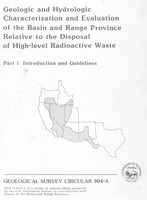Geologic and hydrologic characterization and evaluation of the Basin and Range Province relative to the disposal of high-level radioactive waste: Part I, Introduction and guidelines
Links
- Document: Report (pdf)
- Related Works:
- Circular 904-B Part II, Geologic and hydrologic characterization
- Circular 904-C Part III, Geologic and hydrologic evaluation
- Superseded Publications:
- Download citation as: RIS | Dublin Core
Abstract
The U.S. Geological Survey's program for geologic and hydrologic evaluation of physiographic provinces to identify areas potentially suitable for locating repository sites for disposal of high-level nuclear wastes was announced to the Governors of the eight States in the Basin and Range Province on May 5, 1981. Representatives of Arizona, California, Idaho, New Mexico, Nevada, Oregon, Texas, and Utah, were invited to cooperate with the Federal Government in the evaluation process. Each Governor was requested to nominate an Earth scientist to represent the State in a province working group composed of State and U.S. Geological Survey representatives. This report, Part I of a three-part report, provides the background, introduction and scope of the study. This part also includes a discussion of geologic and hydrologic guidelines that will be used in the evaluation process and illustrates geohydrologic environments and the effect of individual factors in providing multiple natural barriers to radionuclide migration.
Part II is a reconnaissance characterization of the geologic and hydrologic factors to be used in the initial screening of the Basin and Range Province. Part III will be the initial evaluation of the Province and will identify regions that appear suitable for further study.
The plan for study of the Province includes a stepwise screening process by which successively smaller land units are considered in increasing detail. Each step involves characterization of the geology and hydrology and selection of subunits for more intensive characterization. Selection of subunits for further study is by evaluation of geologic and hydrologic conditions following a set of guidelines. By representation on the Province Working Group, the States participate in a consultation and review role in: (1) Establishing geologic and hydrologic guidelines, and (2) characterizing and evaluating the Province. The States also participate in compilation of geologic and hydrologic data used in characterizing the Province.
The current (1983) needs for a high-level radioactive waste repository include: (1) Disposal in a mined repository; (2) retrievability of the waste for as much as 50 years; and (3) confidence of isolation of the waste from the accessible environment. Isolation of the waste needs to be assured using geologic and hydrologic conditions that: (1) Minimize risk of inadvertent future intrusions by man; (2) minimize the possibility of disturbance by processes that would expose the waste or increase its mobility; and (3) provide a system of natural barriers to the migration of waste by ground water. The guidelines adopted by the Province Working Group are designed to provide a standard with which these conditions can be compared.
The guidelines can be grouped into four principal categories: (1) Potential host media, (2) ground-water conditions, (3) tectonic conditions, and. (4) occurrence of natural resources. Ideally the host medium constitutes the first natural barrier to migration of radionculides. The host medium ideally should be a rock type that prevents or retards dissolution and transport of radionuclides. Rocks in both the saturated and unsaturated zones may have desirable characteristics for host media. Rocks-other than the host-in the ground-water flow path from the repository ideally should be major barriers to radionuclide migration. Confining beds of low permeability might be present to retard the rate of flow between more permeable beds. Additionally, sorption of radionuclides by materials such as clays and zeolites in the flow path can further retard the flow of radionuclides by several orders of magnitude. Tectonic conditions in an area should not present a probable cause for exhumation or increased mobility of radioactive waste. Natural resources are a factor for consideration because of the problem of future human intrusion and exposure to radioactivity in the quest for minerals, oil, gas, water, and geothermal resources.
The ultimate evaluation of the suitability of a geohydrologic environment for developing a mined repository needs to assess all geologic and hydrologic characteristics and their interaction in providing confidence that a geohydrologic environment will effectively isolate radionuclides from human access. Several hypothetical settings with typical geohydrologic conditions in the Basin and Range Province are used to illustrate the effect of multiple barriers in the isolation of radionuclides.
Study Area
| Publication type | Report |
|---|---|
| Publication Subtype | USGS Numbered Series |
| Title | Geologic and hydrologic characterization and evaluation of the Basin and Range Province relative to the disposal of high-level radioactive waste: Part I, Introduction and guidelines |
| Series title | Circular |
| Series number | 904 |
| Chapter | A |
| DOI | 10.3133/cir904A |
| Year Published | 1984 |
| Language | English |
| Publisher | U.S. Government Printing Office |
| Publisher location | Washington, D.C. |
| Contributing office(s) | Utah Water Science Center |
| Description | viii, 16 p. |
| Public Comments | This is Part I of a series of reports being prepared by the U.S. Geological Survey in consultation with States in the Basin and Range Province. |
| Country | United States |
| State | Arizona, California, Idaho, Nevada, New Mexico, Oregon, Texas |
| Other Geospatial | Basin and Range Province |


